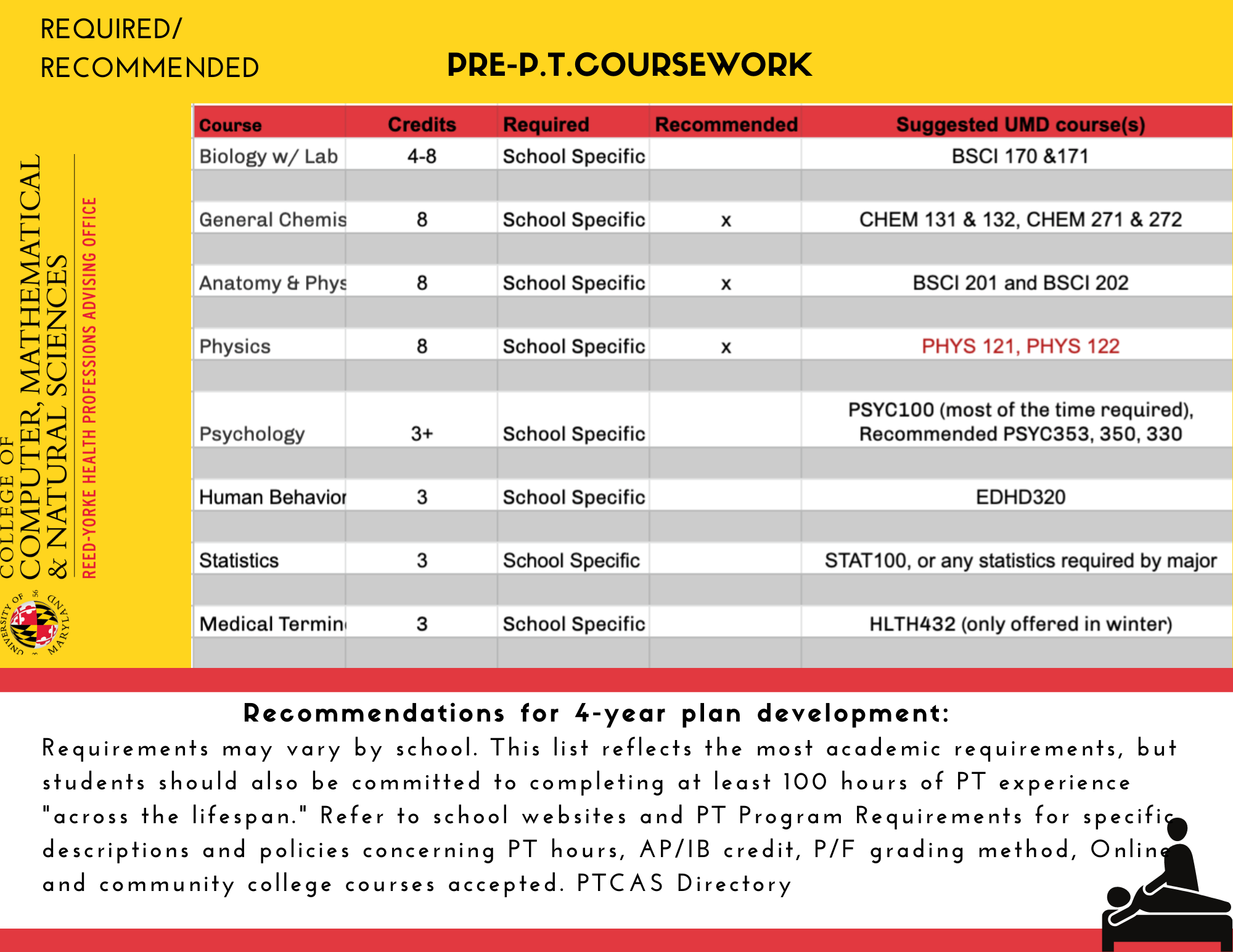Physical Therapists (PTs) work on healthcare teams with physical therapist assistants, physical therapist aids, and other healthcare specialists. They can work in private offices, clinics, hospitals, and nursing homes. They help injured or ill patients improve movement and manage pain using exercises, manipulations of joints and muscles, and training in functional movement. Physical therapists may specialize in certain areas, such as orthopedics or geriatrics. For more information, please see the PT profile in the Bureau of Labor Statistics’ Occupational Outlook Handbook.
A doctoral degree is required in order to become a Physical Therapist (PT). These programs are generally 3-4 years long, at the end of which students receive their Doctor of Physical Therapy (DPT) degree. Master’s degree programs were discontinued as being sufficient for clinical practice by the American Physical Therapy Association in 2015. Most PT programs require students to have a Bachelor’s Degree and to have successfully completed a series of prerequisite courses. However, there are some “3+3” and freshmen entry programs.
PT programs do not require a specific major in order to apply, and the University of Maryland does not offer a “Pre-PT” major, degree, or certificate. However, the University of Maryland does offer the prerequisite courses needed for admission to a PT program, and offers advising for Pre-PT students. Students can also utilize resources such as the American Physical Therapy Association’s (APTA’s) PT Education Overview.

While prerequisites vary slightly from school to school, common prerequisites can include (but are not limited to):
- General Biology
- Human Anatomy and Physiology
- General Chemistry 1
- General Chemistry 2
- General Psychology
- Abnormal Psychology
- UMD has this course in two different stages Adult Psychopathology (PSYC353) and Child Psychopathology (PSYC330)
- Developmental Psychology (PSYC355)
- Physics
- Mathematics
- English Composition
- Statistics
In addition, there are many Minors that cover topics critical to expanding understanding of the various determinants of health. Coursework related to Diversity, Equity, and Inclusion can be helpful in developing cultural awareness, cultural humility, and an understanding of systemic discrimination in the health care system. Even if your academic plan does not permit adding a minor, it is worth reviewing the curated course lists for courses that will stretch you, increase your language for difference and disparity, show your intellectual curiosity, and improve your critical reasoning skills.
Students can use the APTA’s Accredited PT & PTA Programs Directory and the PTCAS Course Prerequisites Comparison Chart to look at specific prerequisite courses for different schools
If you need to take a PSYC course here at UMD that is restricted to PSYC majors only, please fill out this form.
While admission requirements can vary from school to school, most programs require at least 100 hours of PT experience (shadowing, volunteering, or work as a PTA or PT Tech) along with experiences that reflect “across the lifespan”. Please utilize the PTCAS Observation Requirements Chart for more information based on specific programs. Most programs also require the Graduate Record Exam (GRE) and a current CPR certificate. However, students should always research schools they are interested in to make sure that they have met all the prerequisite requirements.
Example of Application Requirements: University of Maryland Baltimore’s DPT program
- Bachelor's Degree (any major)
- Successful completion (a grade of C or better) of specified prerequisite coursework
- An overall GPA of 3.0, and a pre-requisite GPA of 3.0
- Submission of GRE (Graduate Record Exam) scores
- Completion of at least 100 hours of documented work or volunteer experience in a PT setting
- Community Service (recommended)
- Submission of 3 reference letters (one from a physical therapist the student has shadowed, one from a service organization, and one from an academic source)
- A current CPR certificate
- Group Interview
Physical Therapy Offers of Admission (2018-2019)
University of Maryland Pre-Physical Therapy Association
Local Professional Programs
- University of Maryland School of Medicine
- University of Maryland Eastern Shore
- George Washington University
- Howard University
National Resources
Alumni Blog: Physical Therapy
There are currently no alumni blog posts tagged with physical therapy.


